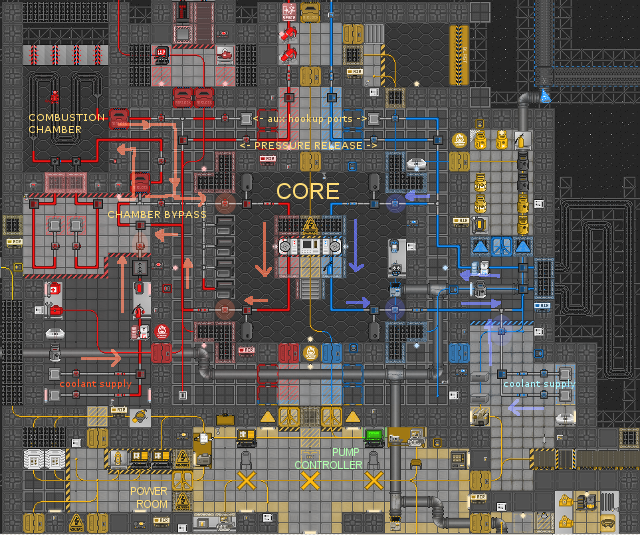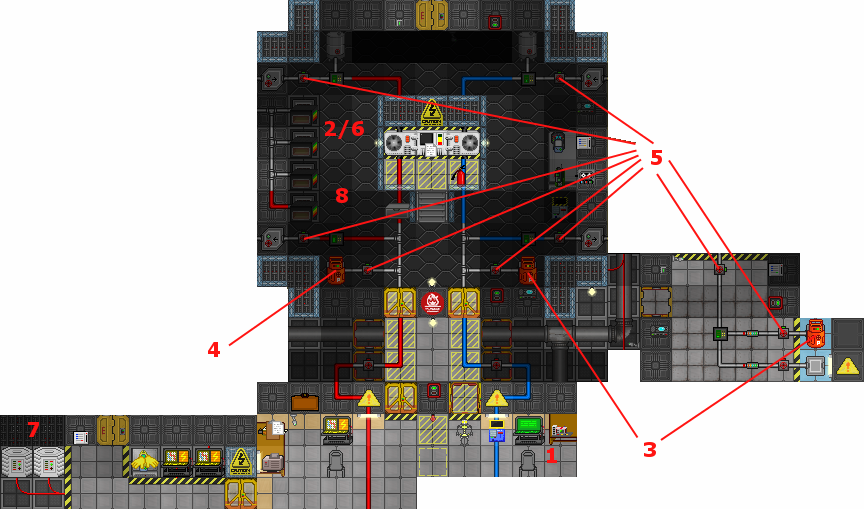Difference between revisions of "Powering the station"
Convair880 (talk | contribs) (Here's some lazy, furnaces-only setup, because I'm tired of power outages. The overview picture of the engine needs to be updated still...) |
|||
| Line 1: | Line 1: | ||
[[File:Engineschematic.png]] | [[File:Engineschematic.png]]<br> | ||
==How | ==How it all works== | ||
The engine has three segments: | The engine has three segments: | ||
* | |||
* | *The hot loop, where heat is generated by heating gas in the furnaces, the combustion chamber or using a mixture that creates fire right in the pipes. | ||
* | *The cold loop that absorbs heat and radiates to space. | ||
*The generator which transfers heat from the hot to the cold loop and produces power. | |||
Four | Four passive gates around the loop keep the gas flowing. | ||
Each canister hookup has its own pump, to increase or decrease the speed of gas injection of into a loop. | Each primary canister hookup has its own pump, to increase or decrease the speed of gas injection of into a loop. | ||
The vents at | The vents at both sides of engineering allow you to remove excessive pressure or scrub a loop of unwanted gas. | ||
==Gas== | ==Gas== | ||
| Line 17: | Line 18: | ||
Gas has some important properties, pressure temperature and heat capacity. | Gas has some important properties, pressure temperature and heat capacity. | ||
*Pressure directs the gas flow from higher to lower pressure pipe segments. If pressure it too high in a pipe, pumps will not be able to move gas, and power output will drop. <br>Above 17, | *Pressure directs the gas flow from higher to lower pressure pipe segments. If pressure it too high in a pipe, pumps will not be able to move gas, and power output will drop. <br>Above 17,000 kPa, pipes have a chance to burst! Check the meters, and use your [[PDA]] or an [[Engineering Objects#Analyzer|analyzer]] on a pipe to read its pressure. | ||
*Temperature causes gas to increase or decrease in pressure. Very little gas when heated can reach gigantic pressure. Conversely, gas in the cold loop will most often be at a low pressure. | *Temperature causes gas to increase or decrease in pressure. Very little gas when heated can reach gigantic pressure. Conversely, gas in the cold loop will most often be at a low pressure. | ||
| Line 23: | Line 24: | ||
*Heat capacity is different for each gas, it determines how quickly a gas can absorb and transfer heat. | *Heat capacity is different for each gas, it determines how quickly a gas can absorb and transfer heat. | ||
Any gas can be used as a medium in both pipe loops; and each gas has a different ability to retain heat or transfer it more quickly. | Any gas can be used as a medium in both pipe loops; and each gas has a different ability to retain heat or transfer it more quickly. Generally, safer gases will yield much lower power outputs. | ||
Generally, safer gases will yield much lower power outputs. | |||
Experimenting with different gas in each loop will let you discover which combinations work best, and how to control the most dangerous gas mixtures. | Experimenting with different gas in each loop will let you discover which combinations work best, and how to control the most dangerous gas mixtures. | ||
| Line 30: | Line 30: | ||
==Pressure== | ==Pressure== | ||
The engine can be efficiently run on very small quantities of gas. Filling the pipes with entire canisters of gas will increase the chance of pressure issues. | The engine can be efficiently run on very small quantities of gas. Filling the pipes with entire canisters of gas will increase the chance of pressure issues. Injecting small quantities of gas in the loops and the combustion chamber over time reduces waste and allows for very high power outputs. | ||
Injecting small quantities of gas in the loops and the combustion chamber over time | |||
Too high pressure inside a pipe will cause it to fracture and leak gas. A broken pipe can be repaired by welding. | Too high pressure inside a pipe will cause it to fracture and leak gas. A broken pipe can be repaired by welding. | ||
Pressure imbalances that stop the correct flow of gas can be controlled by venting gas (either to a canister, or to space). Venting is more effective when gas flow is temporarily blocked by shutting down the proper valve | Pressure imbalances that stop the correct flow of gas can be controlled by venting gas (either to a canister, or to space). Venting is more effective when gas flow is temporarily blocked by shutting down the proper valve. | ||
==An example to get you started== | |||
[[Image:LazyFurnacesSetup.png]] | |||
The following setup is safe, straight-forward and almost maintenance-free. If it is your first day on the job, it may be useful as a starting point, to observe how the engine behaves under load. Or perhaps you're just interested in something nice and easy to keep the lights on. | |||
*'''1.''' Set all engine pumps to one. | |||
*'''2.''' Dump some [[Guide to Mining#Ore|char ore]] in the furnaces. | |||
*'''3.''' Connect one tank of [[Gas#Plasma|plasma]] to the cold loop and another one to the engine room's auxiliary port. | |||
*'''4.''' For the hot loop, take a canister of plasma and connect it to the auxiliary port on the opposite side. | |||
*'''5.''' Open the corresponding valves. | |||
*'''6.''' Activate the [[Engineering Objects#Furnaces|furnaces]]. | |||
*'''7.''' Set both [[Engineering Objects#SMES|SMES units]] to 200.000 input and 100.000 output. | |||
*'''8.''' Come back ~30 min later and load more ore in the furnaces. | |||
If you follow these steps correctly, the engine should generate a steady ~1.3 MW for the duration of a typical shift. [[Guide to Mining#Ore|Plasmastone]], when available, can be used to increase the output. | |||
[[Category:Tutorial]] | [[Category:Tutorial]] | ||
Revision as of 11:26, 13 February 2014
How it all works
The engine has three segments:
- The hot loop, where heat is generated by heating gas in the furnaces, the combustion chamber or using a mixture that creates fire right in the pipes.
- The cold loop that absorbs heat and radiates to space.
- The generator which transfers heat from the hot to the cold loop and produces power.
Four passive gates around the loop keep the gas flowing.
Each primary canister hookup has its own pump, to increase or decrease the speed of gas injection of into a loop.
The vents at both sides of engineering allow you to remove excessive pressure or scrub a loop of unwanted gas.
Gas
Gas has some important properties, pressure temperature and heat capacity.
- Pressure directs the gas flow from higher to lower pressure pipe segments. If pressure it too high in a pipe, pumps will not be able to move gas, and power output will drop.
Above 17,000 kPa, pipes have a chance to burst! Check the meters, and use your PDA or an analyzer on a pipe to read its pressure.
- Temperature causes gas to increase or decrease in pressure. Very little gas when heated can reach gigantic pressure. Conversely, gas in the cold loop will most often be at a low pressure.
- Heat capacity is different for each gas, it determines how quickly a gas can absorb and transfer heat.
Any gas can be used as a medium in both pipe loops; and each gas has a different ability to retain heat or transfer it more quickly. Generally, safer gases will yield much lower power outputs.
Experimenting with different gas in each loop will let you discover which combinations work best, and how to control the most dangerous gas mixtures.
Pressure
The engine can be efficiently run on very small quantities of gas. Filling the pipes with entire canisters of gas will increase the chance of pressure issues. Injecting small quantities of gas in the loops and the combustion chamber over time reduces waste and allows for very high power outputs.
Too high pressure inside a pipe will cause it to fracture and leak gas. A broken pipe can be repaired by welding.
Pressure imbalances that stop the correct flow of gas can be controlled by venting gas (either to a canister, or to space). Venting is more effective when gas flow is temporarily blocked by shutting down the proper valve.
An example to get you started
The following setup is safe, straight-forward and almost maintenance-free. If it is your first day on the job, it may be useful as a starting point, to observe how the engine behaves under load. Or perhaps you're just interested in something nice and easy to keep the lights on.
- 1. Set all engine pumps to one.
- 2. Dump some char ore in the furnaces.
- 3. Connect one tank of plasma to the cold loop and another one to the engine room's auxiliary port.
- 4. For the hot loop, take a canister of plasma and connect it to the auxiliary port on the opposite side.
- 5. Open the corresponding valves.
- 6. Activate the furnaces.
- 7. Set both SMES units to 200.000 input and 100.000 output.
- 8. Come back ~30 min later and load more ore in the furnaces.
If you follow these steps correctly, the engine should generate a steady ~1.3 MW for the duration of a typical shift. Plasmastone, when available, can be used to increase the output.

